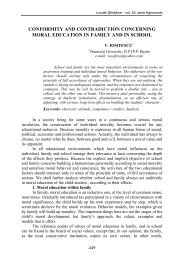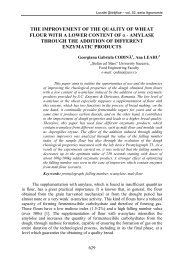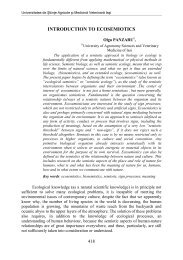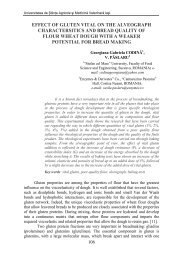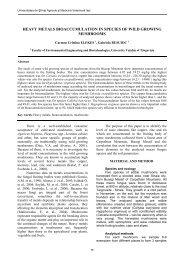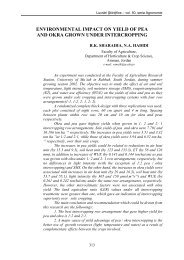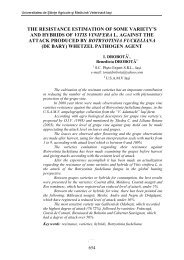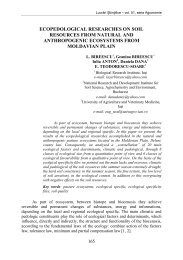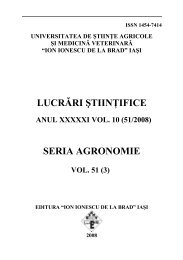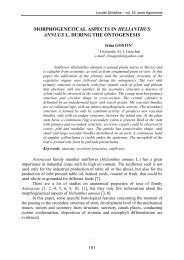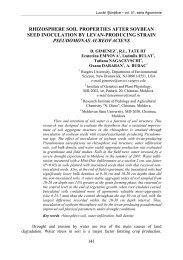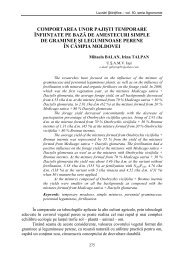biochemical parameters of typical chernozem soil under sunflower ...
biochemical parameters of typical chernozem soil under sunflower ...
biochemical parameters of typical chernozem soil under sunflower ...
Create successful ePaper yourself
Turn your PDF publications into a flip-book with our unique Google optimized e-Paper software.
Lucrări Ştiinţifice – vol. 53, Nr. 2/2010, seria Agronomie<br />
BIOCHEMICAL PARAMETERS OF TYPICAL CHERNOZEM SOIL UNDER<br />
SUNFLOWER AND VETCH+OATS IN CROP ROTATION WITH DIFFERENT<br />
FERTILIZATION<br />
Ecaterina EMNOVA 1 , S. TOMA 1 , B. BOINCEAN 2 , L. NICA 2 ,<br />
Oxana DARABAN 1 , Iana DRUTA 1 , S. STADNIC 2<br />
1<br />
Institute <strong>of</strong> Genetics and Plant Physiology, Chisinau, Republic <strong>of</strong> Moldova<br />
2<br />
Scientific and Practical Center «Selectia», Balti, Republic <strong>of</strong> Moldova<br />
Abstract<br />
The aim <strong>of</strong> research was to compare <strong>soil</strong> biological properties <strong>under</strong> three fertilization systems in crop rotation..<br />
The objective was to evaluate the impact <strong>of</strong> organic fertilizers in crop rotation on enzymatic activities representative <strong>of</strong><br />
some steps <strong>of</strong> biogeochemical nutrient cycles: C(invertase), N(urease), P(phosphatase), and general microbial activity<br />
(basal <strong>soil</strong> respiration, ammonification capacity, dehydrogenase activity) in comparison to mineral and mixed<br />
fertilization. It was shown, the majority <strong>of</strong> <strong>biochemical</strong> <strong>parameters</strong> studied was reduced in <strong>soil</strong> <strong>under</strong> mixture<br />
vetch+oats followed <strong>sunflower</strong> in crop rotation, though the tendencies <strong>of</strong> change were similar. The enzyme activities<br />
were expressed per unit <strong>of</strong> <strong>soil</strong> organic carbon and it didn’t change the previous conclusion: the urease and phosphatase<br />
activities increased, but the invertase activity reduced in <strong>soil</strong> fertilized by manure in comparison to NPK amendment.<br />
Soil basal respiration at field <strong>under</strong> <strong>sunflower</strong> was significantly lower (P
Universitatea de Ştiinţe Agricole şi Medicină Veterinară Iaşi<br />
<strong>sunflower</strong> both <strong>under</strong> three fertilization systems -<br />
organic, mineral and organo-mineral.<br />
MATERIAL AND METHOD<br />
Long-term experiment <strong>of</strong> field crops was<br />
established in 1971 in Balti steppe (North <strong>of</strong><br />
Moldova Republic) on <strong>typical</strong> <strong>chernozem</strong> <strong>soil</strong>.<br />
Since 1991, three fertilization systems are studied<br />
in crop rotation: Mineral (MF) - NPK (130 kg active<br />
substance ha -1 <strong>of</strong> rotation surface), organic (OF) -<br />
cattle manure (15 t ha -1 <strong>of</strong> rotation surface), and<br />
mixed - the sum <strong>of</strong> indicated amounts <strong>of</strong> mineral<br />
and organic fertilizers (MOF).<br />
Soil dehydrogenase activity (DH) (EC<br />
1.1.1.1) was determined by a modified method <strong>of</strong><br />
Galstean (1978). Urease activity (Ure) (EC 3.5.1.5)<br />
was measured by the method <strong>of</strong> Khaziev (1990).<br />
Alkaline phosphatase activity (AlkP) (EC 3.1.3.1) –<br />
by the method <strong>of</strong> Tabatabai and Bremner (1969).<br />
Invertase activity (Inv) (EC 3.2.1.26) – by a<br />
modified method <strong>of</strong> Ci<strong>under</strong>ova (1971) and<br />
Galstean (1978).<br />
Soil basal respiration (SBR) was determined<br />
by the method proposed by Isermeyer (1952) and<br />
taking into account changes introduced by Dilly<br />
and Nannipieri (2001) after incubation <strong>of</strong> <strong>soil</strong><br />
samples (10 g <strong>of</strong> each) for 7 days at 21°C, with<br />
optimum water content. The amount <strong>of</strong> CO 2<br />
released during incubation, and interacted with<br />
NaOH, was determined by titrimetry. Nitrogen<br />
mineralization capacity (ammonification) (NMC, N-<br />
NH 4 + ) was determined simultaneously with SBR<br />
analysis. From <strong>soil</strong> samples taken both before as<br />
well as those after incubation, ammoniacal<br />
nitrogen was extracted with 0.05 N NaCl solution<br />
(<strong>soil</strong>: solution ratio <strong>of</strong> 1:30). The quantity <strong>of</strong><br />
ammoniacal nitrogen (N-NH 4 + ) was determined<br />
using Nessler reagent (Mineev, 1989). NMC (mg<br />
N-NH 4 + g <strong>soil</strong> -1 day -1 21°C) was calculated from the<br />
difference between values obtained in samples<br />
after and before incubation.<br />
Total organic carbon (TOC) content was<br />
determined in air-dried <strong>soil</strong> samples by wet<br />
oxidation with potassium dichromate in an acid<br />
environment, and then by dosage <strong>of</strong> remained<br />
potassium dichromate excess by use the method<br />
<strong>of</strong> Tiurin (Arinushkina, 1970). pH values were<br />
measured using a glass electrode, based on the<br />
ratio <strong>of</strong> <strong>soil</strong> to 1 M KCl solution 1:2.5 g / ml (weight:<br />
volume).<br />
Mobile ammoniacal nitrogen (N-NH 4 + ) from<br />
<strong>typical</strong> <strong>chernozem</strong> was extracted with 0.05 N NaCl<br />
solution (1:30 ratio <strong>of</strong> <strong>soil</strong> to solution) and<br />
subsequently measured with Nessler reagent<br />
(Mineev, 1989).<br />
Inorganic phosphorus (P i ) was extracted<br />
with 0.5 N acetic acid (1:25 ratio <strong>of</strong> <strong>soil</strong> to solution)<br />
according to method proposed by Ciricov (Mineev,<br />
1989) and then was determined by the method <strong>of</strong><br />
Murphy and Riley (1962). Water content <strong>of</strong> <strong>soil</strong> and<br />
absolutely dry <strong>soil</strong> mass were determined<br />
immediately after sampling by drying for 6-24<br />
hours at 105°C.<br />
Data analysis was performed by use <strong>of</strong><br />
Micros<strong>of</strong>t Excel for Windows XP (Micros<strong>of</strong>t Office).<br />
Matrix were analyzed with the same dimensions.<br />
Mean values were analyzed by Student t-test<br />
(bilateral test, type 3 with unequal variances) (Aon<br />
et al., 2001) at the P< 0.05 level.<br />
RESULTS AND DISCUSSIONS<br />
General <strong>biochemical</strong> <strong>parameters</strong>. Soil basal<br />
respiration (SBR) and nitrogen mineralization<br />
capacity (NMC, ammonification, N-NH 4+ )<br />
provides a general characterization <strong>of</strong> biological<br />
processes <strong>of</strong> organic matter mineralization in<br />
arable <strong>soil</strong>.<br />
SBR indicates the rate <strong>of</strong> degradation <strong>of</strong> <strong>soil</strong><br />
organic matter. This parameter was significantly<br />
increased (P
Lucrări Ştiinţifice – vol. 53, Nr. 2/2010, seria Agronomie<br />
data were too variable for <strong>soil</strong> <strong>under</strong> vetch+oats.<br />
Thus, organic fertilization contributes to activation<br />
<strong>of</strong> <strong>soil</strong> microbial communities due to the addition<br />
<strong>of</strong> nutrients.<br />
Specific <strong>biochemical</strong> <strong>parameters</strong>. Urease<br />
activity (Ure) showed the same trend in both <strong>soil</strong><br />
samples <strong>under</strong> the studied crops (fig. 2). Lower Ure<br />
activity was observed in mineral fertilization, and<br />
significantly higher values were recorded in<br />
organic and organo-mineral fertilization. For the<br />
last two fertilization systems Ure activity in <strong>soil</strong><br />
<strong>under</strong> <strong>sunflower</strong> was significantly higher as<br />
compared with the vetch+oats, which followed the<br />
<strong>sunflower</strong>. Thus, manure amendment in <strong>soil</strong> <strong>under</strong><br />
<strong>sunflower</strong> activated urease activity and urea<br />
decomposition. These significant changes probably<br />
are caused by changes in microbial community<br />
structure due to organic fertilization system noticed<br />
earlier by the another researchers (Schloter et al.,<br />
1998).<br />
Alkaline phosphatase activity (AlkP), only<br />
in <strong>soil</strong> <strong>under</strong> <strong>sunflower</strong> with mineral fertilizers was<br />
significantly (P
Universitatea de Ştiinţe Agricole şi Medicină Veterinară Iaşi<br />
Enzyme ac tivity units/C<br />
45<br />
40<br />
35<br />
30<br />
25<br />
20<br />
15<br />
10<br />
5<br />
0<br />
Ure/C AlkP /C Inv/C<br />
S unflower MF Sunflower MOF Sunflower OF<br />
V etc h+ oats MF V etc h+ oats MOF V etc h+ oats OF<br />
Figure 2 Specific <strong>biochemical</strong> <strong>parameters</strong> <strong>of</strong> <strong>typical</strong> <strong>chernozem</strong><br />
Ure – Urease activity; AlkP – Phospatase activity alcalină; Inv – Invertase activity<br />
Units (see the legend and the note)<br />
14<br />
12<br />
10<br />
8<br />
6<br />
4<br />
2<br />
0<br />
13,2<br />
12,6<br />
11,7<br />
8,3<br />
7,8<br />
8,2<br />
6,2<br />
6,1<br />
5,65,8<br />
4,8<br />
5,2 5,4<br />
4,8 4,6<br />
4,3 4,3 4,5<br />
1,5<br />
1,6<br />
1,2<br />
1,1 1,01,2<br />
SOM N-NH4 P2O5 pH<br />
Sunflower OM Sunflower MOF Sunflower OF<br />
Vetch+oats OM Vetch+oats MOF Vetch+oats OF<br />
Figure 3 Agrochemical <strong>parameters</strong> <strong>of</strong> <strong>typical</strong> <strong>chernozem</strong><br />
SOM – Soil Organic Matter; N-NH 4 – ammoniacal N; P 2 O 5 – inorganic P<br />
Harvest, t ha ‐1<br />
25<br />
20<br />
15<br />
10<br />
16,0<br />
20,9 21,2<br />
5<br />
0<br />
2,1 2,1 2,3<br />
MF OF MOF MF OF MOF<br />
S unflower (s eeds )<br />
Vetch+oats (green mass)<br />
Figure 4 Yield (t ha -1 ) <strong>of</strong> <strong>sunflower</strong> and vetch+oats in crop rotation<br />
with different fertilization systems<br />
12
Lucrări Ştiinţifice – vol. 53, Nr. 2/2010, seria Agronomie<br />
Yield <strong>of</strong> <strong>sunflower</strong> and vetch+oats in crop<br />
rotation. The overall ecosystem productivity and<br />
the productivity <strong>of</strong> crops in agricultural ecosystem<br />
is among the important criteria <strong>of</strong> <strong>soil</strong> health and<br />
quality. The data <strong>of</strong> <strong>sunflower</strong> yield show that<br />
indicated crop depends on <strong>soil</strong> fertilization system<br />
very insignificant (fig. 4). Only mixed fertilization<br />
system showed positive trend in yield increasing.<br />
These results are confirmed over several years<br />
(Nica, 2008; Boincean, 2008).<br />
On the contrary, the yield <strong>of</strong> mixture<br />
vetch+oats increased significantly with manure<br />
amendment (34%) compared with using only the<br />
mineral system.<br />
However, the hypothesized supposition that<br />
the low reacting <strong>of</strong> <strong>sunflower</strong> on fertilizer<br />
amendment is provoked by unknown restrictions<br />
for <strong>soil</strong> <strong>biochemical</strong> (microbiological) processes<br />
which deal with nutrient availability for plant<br />
should be investigated more deeply in the limits <strong>of</strong><br />
the whole crop rotation (6 crops). The important<br />
observation for top <strong>soil</strong> layer (0-20 cm) <strong>under</strong><br />
vetch+oats is significantly lower <strong>soil</strong> organic<br />
matter content, this fact requires especial attention<br />
to technology <strong>of</strong> <strong>sunflower</strong> cultivation in crop<br />
rotation.<br />
Correlations between <strong>biochemical</strong> and<br />
chemical variables. The analysis <strong>of</strong> correlations<br />
performed separately for both selected crops and<br />
for each <strong>of</strong> system fertilization has shown a<br />
complicate picture regarding to the presence or<br />
absence <strong>of</strong> correlations, and the change from<br />
positive to negative correlations. In <strong>soil</strong>s <strong>under</strong><br />
<strong>sunflower</strong> (cultivated after spring barley) BSR in 2<br />
treatments <strong>of</strong> 3 did not correlated with SOM. Only<br />
at OF was revealed poor but significant negative<br />
correlation (r = -0.49). In <strong>soil</strong>s <strong>under</strong> vetch and<br />
oats (cultivated after <strong>sunflower</strong>) the BSR and<br />
SOM have shown the high positive correlation at<br />
OF (r = 0.86), and poor negative correlation at MF<br />
(r = - 0.52). The ammonification process positively<br />
correlated with SOM <strong>under</strong> both crops at MF,<br />
only, respectively, r = 0.90 <strong>under</strong> <strong>sunflower</strong>, r =<br />
0.69 <strong>under</strong> vetch and oats. DH activity correlated<br />
with SOM in <strong>soil</strong>s <strong>under</strong> <strong>sunflower</strong>, only. The Ure<br />
and AlkP activities as a rule correlated with SOM,<br />
but the relationship changed from positive to<br />
negative correlations. Inv activity did not<br />
correlated with SOM in all studied <strong>soil</strong>s.<br />
Good positive correlation between pH<br />
values and DH activity was observed at MF and<br />
OF <strong>under</strong> both crops, as well as for Ure activity<br />
<strong>under</strong> <strong>sunflower</strong>. The nutrient components:<br />
ammoniacal N and inorganic P - positively<br />
correlated with Ure and AlkP activities in most<br />
treatments, while, in general, <strong>soil</strong>s amended by<br />
organic fertilizers were not characterized by<br />
increase <strong>of</strong> correlations between <strong>biochemical</strong> and<br />
chemical <strong>parameters</strong> <strong>under</strong> both crops.<br />
Biochemical properties were influenced<br />
significantly by <strong>soil</strong> water content more <strong>of</strong>ten at<br />
MF, at that, the most correlations were negative<br />
<strong>under</strong> <strong>sunflower</strong>, and positive <strong>under</strong> vetch+oats.<br />
Correlations between general and specific<br />
<strong>biochemical</strong> <strong>parameters</strong>. The mutual correlations<br />
between general and specific <strong>biochemical</strong><br />
<strong>parameters</strong> within fertilization systems and<br />
cultivated plants did not revealed strict regularity,<br />
especially in <strong>soil</strong>s <strong>under</strong> <strong>sunflower</strong>. At that, just in<br />
<strong>soil</strong> <strong>under</strong> <strong>sunflower</strong> at OF system the specific<br />
<strong>biochemical</strong> <strong>parameters</strong> were highly positively<br />
correlated each other. Besides that, it can be<br />
noticed <strong>under</strong> mixture vetch and oats an increase <strong>of</strong><br />
correlations between all <strong>biochemical</strong> <strong>parameters</strong> at<br />
OF and especially at MOF.<br />
Data obtained in the present research show<br />
that three types <strong>of</strong> <strong>soil</strong> fertilization generates<br />
significant changes in <strong>biochemical</strong> properties <strong>of</strong><br />
<strong>typical</strong> <strong>chernozem</strong>. Values <strong>of</strong> <strong>biochemical</strong><br />
<strong>parameters</strong> were lower in <strong>soil</strong> amended with<br />
mineral fertilizers versus the ones in <strong>soil</strong> fertilized<br />
with organic and mixed mineral+organic fertilizers<br />
for both crops studied. These significant changes<br />
probably are caused by changes in microbial<br />
community structure due to difference in<br />
fertilization system. Values <strong>of</strong> most <strong>biochemical</strong><br />
<strong>parameters</strong> investigated were lower in <strong>soil</strong> <strong>under</strong><br />
vethc+oats following <strong>sunflower</strong> in rotation. This<br />
fact may be explained by biological feature <strong>of</strong><br />
<strong>sunflower</strong> to absorb nutrients from deep <strong>soil</strong><br />
reserves, including from <strong>soil</strong> organic matter.<br />
Therefore, <strong>soil</strong> fertilization with manure just <strong>under</strong><br />
<strong>sunflower</strong> has a positive impact on <strong>soil</strong> fertility for<br />
next crop vetch+oats following in the crop rotation.<br />
Biochemical and agrochemical properties <strong>of</strong> <strong>soil</strong><br />
improves, and the productivity <strong>of</strong> vetch+oats<br />
increases. Thus, the organic fertilization system<br />
acts most favorable on <strong>soil</strong> biological properties,<br />
namely the enzymatic activities, which are the<br />
main stages <strong>of</strong> transformation <strong>of</strong> <strong>soil</strong> organic<br />
matter, including its labile fraction.<br />
CONCLUSIONS<br />
Of three system <strong>of</strong> fertilization studied,<br />
organic fertilization system work more favorable<br />
on biological properties <strong>of</strong> <strong>soil</strong>, namely the<br />
enzymatic activities, which are the main stages <strong>of</strong><br />
transformation <strong>of</strong> <strong>soil</strong> organic matter, including its<br />
labile fraction. The specific <strong>biochemical</strong><br />
<strong>parameters</strong> were highly positively correlated each<br />
other in <strong>soil</strong> <strong>under</strong> <strong>sunflower</strong> just at OF system.<br />
13
Universitatea de Ştiinţe Agricole şi Medicină Veterinară Iaşi<br />
The increase <strong>of</strong> correlations between all<br />
<strong>biochemical</strong> <strong>parameters</strong> at OF and especially at<br />
MOF was noticed <strong>under</strong> mixture vetch and oats.<br />
The hypothesized supposition that the low reacting<br />
<strong>of</strong> <strong>sunflower</strong> on fertilizer amendment is provoked<br />
by unknown restrictions for <strong>soil</strong> <strong>biochemical</strong><br />
(microbiological) processes, which deal with<br />
nutrient availability for plant, should be<br />
investigated more deeply.<br />
BIBLIOGRAPHY<br />
Aon, M.A., Cabello, M.N., Sarena, D.E., Colaneri,<br />
A.C., Franco, M.G., Burgos, J.L., Cortassa, S.,<br />
2001 - Spatio-temporal patterns <strong>of</strong> <strong>soil</strong> microbial<br />
and enzymatic activities in an agricultural <strong>soil</strong>,<br />
Appl. Soil Ecol., vol. 18, p. 239-254.<br />
Arinushkina, E.V., 1980 – Agrochemical methods <strong>of</strong> <strong>soil</strong><br />
analysis, Editura Nauka, Мoscow. 150pp.<br />
Badiane, N.N.Y., Chotte, J.L., Pate, E., Masse, D.,<br />
Rouland, C., 2001 - Use <strong>of</strong> <strong>soil</strong> enzyme activities<br />
to monitor <strong>soil</strong> quality in natural and improved<br />
fallows in semi-arid tropical regions, Appl. Soil<br />
Ecol., vol.18, p. 229-238.<br />
Boincean, B. 2008 - Importance <strong>of</strong> crop rotation and <strong>soil</strong><br />
fertility for row crops in Republic <strong>of</strong> Moldova. In:<br />
Technical crops for modern agriculture, Int. conf.<br />
Balti, Moldova. P. 115-119.<br />
Ci<strong>under</strong>ova, A.I., 1971 - The method <strong>of</strong> <strong>soil</strong> invertase<br />
activity determination. Microbiological and<br />
<strong>biochemical</strong> research <strong>of</strong> <strong>soil</strong>, Editura Urojai, Kiev,<br />
p.128-130.<br />
Dick, R.P., 1994 - Soil enzyme activities as indicators <strong>of</strong><br />
<strong>soil</strong> quality. In: Doran J.W., Coleman D.C.,<br />
Bezdicek D.F., Stewart B.A. (eds.) Defining <strong>of</strong><br />
Soil Quality for a Sustainable Environment.<br />
SSSA, Madison, p.107-124.<br />
Dick, W.A., Tabatabai M.A., 1993 - Significance and<br />
potential uses <strong>of</strong> <strong>soil</strong> enzymes, In: Metting F.P.,<br />
(ed.) Soil Microbial Ecology. Application in<br />
Agricultural and Environment Management,<br />
Marcel Dekker, New York, pp. 95-125.<br />
Dick, R.P., Breackwill, D., Turco, R., 1996 - Soil<br />
enzyme activities and biodiversity measurements<br />
as integraiting biological indicators, In: Doran<br />
J.W., Jones A.J., (eds). Handbook <strong>of</strong> Methods for<br />
Assessment <strong>of</strong> Soil Quality. SSSA, Madison, p.<br />
247-272.<br />
Dilly, O., Nannipieri, P., 2001 - Response <strong>of</strong> ATP<br />
content, respiration rate and enzyme activities in<br />
an arable and a forest <strong>soil</strong> to nutrient additions,<br />
Biol. Fertil. Soils 34: 64-72.<br />
Doran, J.W., Zeiss, M.R., 2000 - Soil health and<br />
sustainability: managing the biotic component <strong>of</strong><br />
<strong>soil</strong> quality, Appl. Soil Ecology, vol.15, p. 3-11.<br />
Еmnova, E.E., 2004 – Modern ecological concept <strong>of</strong> <strong>soil</strong><br />
quality as a part <strong>of</strong> sustainable agriculture<br />
concept, Buletinul AŞ RM. Ştiinţe biol., chim. şi<br />
agr., nr. 4 (294), p. 63-70.<br />
Isermeyer, H., 1952 - Estimation <strong>of</strong> <strong>soil</strong> respiration in<br />
closed jars, In: Alef, K., Nannipieri, P. (Eds),<br />
Method in Applied Soil Microiology and<br />
Biochemistry. London, 1995. p. 214-216.<br />
Galstean, A., 1978 - Determination <strong>of</strong> <strong>soil</strong> enzyme<br />
activity, Erevan, 55pp;<br />
Khaziev, F.X., 1990 - Methods <strong>of</strong> <strong>soil</strong> enzymology,<br />
Editura Nauka, Moscow. 190pp.<br />
Liu, Bo., Tu, C., Hu S., Gumpertz, M., Ristaino, J.B.,<br />
2007 - Effect <strong>of</strong> organic, sustainable, and<br />
conventional management strategies in grower<br />
fields on <strong>soil</strong> physical, chemical, and biological<br />
factors and the incidence <strong>of</strong> Southern blight,<br />
Appl. Soil Ecology, vol. 37, p. 202-214.<br />
Mineev, V.G., 1989 - Handbook <strong>of</strong> agrochemistry,<br />
Editura Moscow State University. 304pp.<br />
Murphy, J., Riley J.P., 1962 – A modified single<br />
solution method for the determination <strong>of</strong><br />
phosphate in natural waters, Anal. Chem. Acta,<br />
vol. 27, p. 31-36.<br />
Nannipieri, P., Ceccanti, B., Grego, S., 1990 -<br />
Ecological significance <strong>of</strong> biological activity in<br />
<strong>soil</strong>. In: Bollag, G.M., Stotzky, G. (Eds.), Soil<br />
Biochemistry, vol. 6. Marcel Dekker, New York,<br />
pp. 293–355.<br />
Nica, L. 2008 - The effect <strong>of</strong> <strong>soil</strong> fertilization system on<br />
the <strong>sunflower</strong> productivity in crop rotation, In:<br />
Technical crops for modern agriculture, Int. conf.<br />
Balti, Moldova, 167-169.<br />
Schloter, M., Zelles, L., Hartman, A., Munch, J.C. ,<br />
1998. - New quality <strong>of</strong> assessment <strong>of</strong> microbial<br />
diversity in arable <strong>soil</strong>s using molecular and<br />
<strong>biochemical</strong> methods, Plant Nutr. Soil Sci., vol.<br />
161, p. 425-431.<br />
Scujins, J., 1978 - Hystory <strong>of</strong> abiontic <strong>soil</strong> enzyme<br />
research, In: Burns, R.G. (Ed.), Soil Enzymes.<br />
Academic Press, London, Chapter 1, p. 1-49.<br />
Senikovskaya, I., 2007 - Enzyme activity in <strong>soil</strong>s <strong>of</strong> a<br />
long-term fertilizer experiment: the comparison <strong>of</strong><br />
the mineral and organic farming system. In:<br />
Sustainable and ecological agriculture: results,<br />
problems and prospects, Balti, Moldova, p. 156-<br />
158.<br />
Stadnic, S., 2006 - Modificarea proprietăţilor<br />
agrochimice a cernoziomului tipic sub influenţa<br />
folosirii de lungă durată a diferitor sisteme de<br />
fertilizare, Agricultura Moldovei, № 4, p. 16-18.<br />
Tabatabai, M.A., Bremner, J.M., 1969 - Use <strong>of</strong> p-<br />
nitrophenyl phosphate for assay <strong>of</strong> <strong>soil</strong><br />
phosphatase activity, Soil Biol. Biochem., vol. 1,<br />
p. 301-307.<br />
Trasar-Cepeda, C., Leirós, M.C., Seoane, S., Gil-<br />
Sotres, F., 2008 - Biochemical properties <strong>of</strong> <strong>soil</strong>s<br />
<strong>under</strong> crop rotation, Appl. Soil Ecol. 39, 133-143.<br />
14




